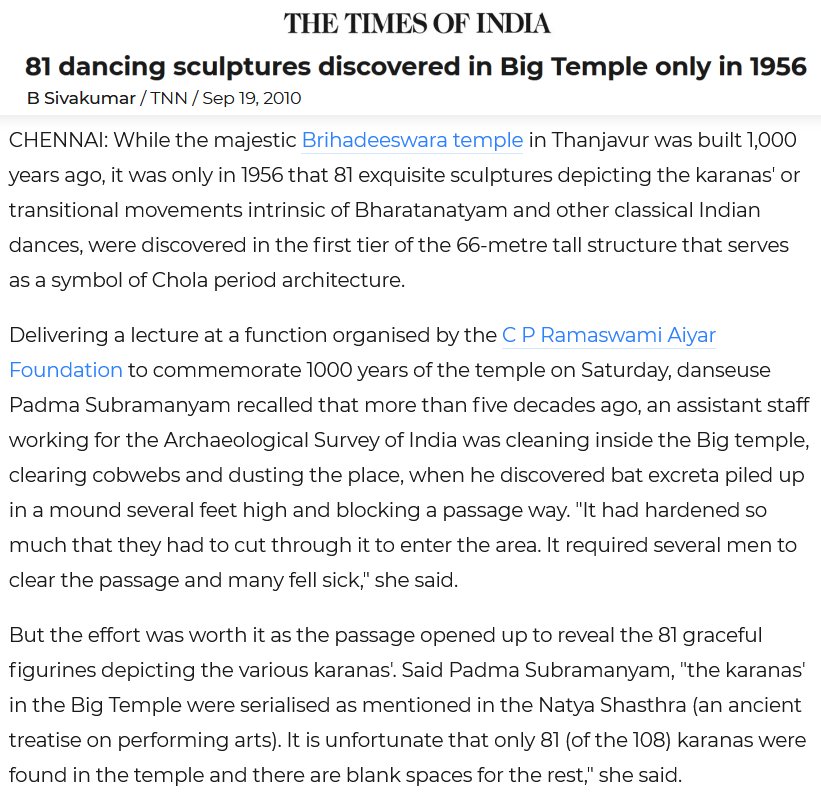Snippets of Information
Dance - Bharatanatyam
Karanas
* 23 Feb 2022
Hasta pada samayogaha nrittasya karanam bhavet - i.e. the combined movements of hands and feet in dance, is called Karana.
Karanas are actions and not static poses. The sculptures are frozen moments of the movements.
Bharatamuni describes its origin and technique in the 4th chapter of
‘Natya Sastra,' which is easily the oldest extant text on Dramaturgy,
Dance, Music and Poetics.
Each Karana is made up of a Sthana, Chari and Nritta Hasta. The entire
gamut of Angika Abhinaya starting from the usage of major and minor
limbs needs to be mastered, to learn the Karanas. 108 Karanas have been
described by Bharatamuni. Bharata's Sutras are too short for a practical
re-construction of these Karanas. Abhinavagupta's commentary, belonging
to the early 11th century from Kashmir, illuminates us on their
performances.
Source: Karanas by Padma Subrahmanyam, Dec 24, 2004, narthaki.com
*21 Feb 2022
Karana means 'action' and in the context of dance it indicates a
coordinated action of the body, the hands and the feet. 108 such karana
or units of dance are named and defined in the Natya Shastra, the most
ancient text on the performing arts composed by Bharata Muni.
Lord Siva bids Tandu initiate His devotees into the secrets of the
difficult art. Tandu proceeds to teach Bharata the 108 karanas. These
are combined into angaharas and into larger choreographies. After Tandu
initiates Bharata the art of dance is given to humanity through
Bharata’s sons and the apsarasas, the heavenly dancers.
Source: Shiva's Karanas in the temples of Tamil Nadu: the Natya
Shastra in stone by Liesbeth Pankaja Bennink, and Kandhan Raja
Deekshithar, Jayakumar Raja Deekshithar, Sankar Raja Deekshithar, August
20, 2013, asianart.com
* 21 Feb 2022
Five temples are well known for the depiction of the karanas as
sculptures. They are the Rajarajeshvara temple in Tanjore, the Nataraja
temple in Chidambaram, the Sarangapani temple in Kumbakonam, the
Arunachaleshvara temple in Thiruvannamalai and the Vriddhagirishvara
temple in Vriddhachalam.
- The oldest of these five examples is the Rajarajeshvara temple in Tanjore built by Rajaraja Chola around the year 1000 CE. A four-armed Shiva is shown dancing the first 81 karanas
in a horizontally placed relief which is on one's right hand side as
the passage is followed in the clock-wise direction. The series has been
left incomplete.
- In Chidambaram the passages through all four gopurams have been decorated with complete representation of all 108 karanas
- In the east gopuram of the Sarangapani temple in Kumbakonam
a more or less complete series is depicted as danced by a male dancer.
The panels are positioned in a horizontal band around the outside of the
gopuram. Here many of the panels are captioned with inscriptions
written in grantha script.
- In Vriddhachalam and in Thiruvannamalai the karanas are found in the gopuram passages. In the Vriddhagirishvara temple
depictions of the karanas are found in all four gopurams, but are
incomplete. Only 101 karanas are represented and in a strikingly unusual
ordering. The construction date of the gopuram is not exactly known. On
the basis of architecture, sculptural style and costume a date in the
14th century is likely, which would place this gopuram after the
construction of the Chidambaram gopuram and before the gopuram of
Thiruvannamalai.
- In Thiruvannamalai all the karanas are systematically arranged
in the east gopuram passage. Besides the 108, possibly copied from
Chidambaram, there are many more dance movements depicted, besides
panels depicting deities, rishis and other mythological figures.
Depictions are found on 20 pilasters with 9 panels arranged vertically,
making 180 panels in all, of which 108 constitute the karanas as defined
in the Natya Shastra. This Raja Gopuram of the Arunachaleshvara temple
in Thiruvannamalai was constructed in the 16th century.
Source: Shiva's Karanas in the temples of Tamil Nadu: the Natya
Shastra in stone by Liesbeth Pankaja Bennink, and Kandhan Raja
Deekshithar, Jayakumar Raja Deekshithar, Sankar Raja Deekshithar, August
20, 2013, asianart.com
* 23 Feb 2022

Source: timesofindia.indiatimes.com
|